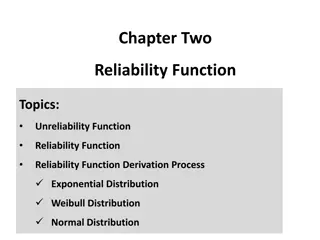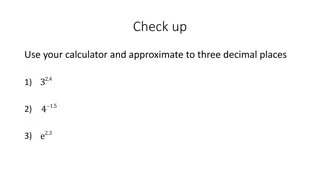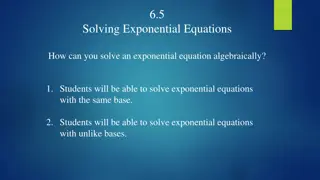Understanding Exponential Growth Functions Based on Gordon's Book
This presentation delves into exponential growth functions using real-world examples such as the population growth of Niger. It covers topics such as algebra with exponents, finding formulas for growth models, terminology, and graphing population growth over time. The content explores how exponential growth leads to significant increases in population and the implications of such rapid growth on resources and sustainability.
Download Presentation

Please find below an Image/Link to download the presentation.
The content on the website is provided AS IS for your information and personal use only. It may not be sold, licensed, or shared on other websites without obtaining consent from the author. Download presentation by click this link. If you encounter any issues during the download, it is possible that the publisher has removed the file from their server.
E N D
Presentation Transcript
Exponential Growth Functions All slides in this presentations are based on the book Functions, Data and Models, S.P. Gordon and F. S Gordon ISBN 978-0-88385-767-0
A Few Problems p. 3
Example 1 We ll study functions that increase in a concave up or a concave down fashion. Consider the population of Niger, growing at rate 3.4% per year (one of the fastest in the world) p. 4
Example 1 Finding a Formula for the Model Note, the population is increasing at an increasing rate, i.e. following a concave up fashion. How to find the respective formula of the function? In general, we have p. 5
Example 1 Finding a Formula for the Model Let t - number of years since 1999 and P(t) population of Niger (in millions) t years after 1999. Then we have P(0) = 11.4; P(1) = 1.034 P(0) = 11.79; P(2) = 1.034(1.034)P(0) = 1.0342?(0) = 12.19; P(3) = 1.034P(2) = 1.034 1.0342? 0 = (1.034)3P(0) = 12.6 If ?0= ?(0) is the initial population we have that ? ? = ?0 (1.034)?= 11.4(1.034)? = ?0 ??, ? ??? ? = 1.034 p. 6
Example 1 - Terminology ? ? = ?0 (1.034)?= 11.4(1.034)? Exponential growth function/model with base b = 1.034. Note, t appears in the exponent. The population in each year is 1.034 times the population of the preceding year. The quantity is 0.034 = 3.4% is the respective annual growth rate, r. Recall that the population of Niger grows at 3.4% per year. Growth Factor = 1 + Growth Rate; b = 1 + r Growth Rate = Growth Factor -1; r = b - 1 Growth rate, r, must be written as a decimal, not a percent. p. 7
Population growth of Niger - Graph Assume that the population in Niger continues to grow at the same exponential rate r = 0.034 for the next 80 years after 1999. Then we can graph the function ? ? = 11.4(1.034)? for t from 0 to 80 What is the real-life meaning of the point (80, 165)? What can we say about this exponential behavior in comparison to the linearly increasing one? We note that even though this exponential model grows quite slowly at the beginning, eventually peaks up to reach very rapid increase leading to huge population for which there may not be enough resources. p. 8
Domain of an Exponential Function Theoretically the domain of an exponential function is all real numbers, , However in real-world setting, there are practical limitations to the domain Niger was only founded in 1960 so using the model to extrapolate its population more than 39 year in the past is obviously meaningless. Going too far into the future or too far back in the past is always risky since many conditions change over time (e.g. drought and famine may slow down the growth of population considerably) and model may not hold p. 9
Range of an Exponential Function Consider a general exponential growth function. It has the form ? = ???, A > 0 A typical graph of such a function looks something like the one on the right How does it grow? In a concave up fashion as we move from left to right What happened as y gets smaller and smaller? It decreases and gets closer and closer to the t-axis We call the t-axis, horizontal asymptote to the graph of the function p. 10
Range of an Exponential Function Remember that So we have numerically, Hence as x gets smaller and smaller, the values of the function approach 0 p. 11
Population growth of Niger Negative Values of the Independent Variable Predict what the population was in 1990 in Niger, assuming the model for the Niger s population was appropriate then ? ? = 11.4(1.034)? Solution: Note 1990 - 1999 = -9 and therefore we plug in P(t), t = -9, to get ? 9 = 11.4(1.034) 9= 11.4(0.74014) 8.44 million people. Note that 8.44<11.4 as expected. p. 12
Example 2 California Population Example 2 The population of California in 2008 was 38 million with an annual growth rate of 1.16%. Write a formula for the population of California at any time after 2008. First, we write the growth rate 1.16% as a decimal r = 0. 0116. This means that the growth factor is b = 1 + r = 1.0116. Initial population is the population in 2008, ?0= 38, in millions. Therefore the exponential growth model is ? ? = ?0?? = 38(1.0116)? p. 13
Other Examples of Exponential Growth Bacteria grows at exponential rate of 8.5% per hour. Its initial amount was 23 billion at 8 AM this morning. Write the formula of this model. ? ? = 23 (1.085)? What will be the amount of the bacteria at 10 AM? t = 2 ; ? 2 = 23 (1.085)2= 27.0761 million How about at 8 PM? t = 12 ; ? 12 = 23 (1.085)12= 61.2187 million p. 14
Other Examples of Exponential Growth A given initial investment of 2000 dollars in January this year grows exponentially at a rate 0.5% per month. Write the formula of this model. ? ? = 2000(1.005)?, t months after last January How much is I(5)? What does it signify in reality? I(5) = 2050.5025 dollars is the value of the investment in June When will this investment reach 8000 dollars? Need to solve 8000 = 2000(1.005)? for t or 4000 = (1.005)? .We ll learn this later p. 15
Mathematical Role of Growth Factor ? ? = ?0 ?? The role of the growth factor b is similar to that of the slope of a linear function. The larger b is, the faster the exponential function grows. Where does the curve lie if b = 1.045? What if b = 1.032? p. 16
Mathematical Role of Initial Population ? ? = ?0 ?? The role of the coefficient ?0is similar to that of the vertical intercept of a linear function. Note when t = 0, ? 0 = ?0 ?0= ?0, i.e. this is the y- intercept of the graph of P(t) p. 17
Linear Growth versus Exponential Growth Linear growth increase by a fixed amount (slope=m); Exponential growth increases by a fixed percent p. 18
Example 3 Population of Mexico Example 3 In 2006, the population of Mexico was 108.3 million and was growing exponentially at a rate of 1.7% per year. a. Find a formula for the population of Mexico at any time t b. Predict the population of Mexico in 2015. Solution: a. ? ? = 108.3(1.017)? b. ? 9 = 108.3(1.017)9 126.16 ??????? ?????? p. 19
Example 4 Loan of NYC Example 4 In the early 1990s, a historian discovered a million-dollar loan that the New York City had made to the U.S. government in 1812. At first, it appeared that the loan had never been repaid. Assuming a 6% annual compound interest rate, what would the value V of this loan have become by 2010? Solution: what is the value of the growth factor? It is = 1 + 0.06 ? ? = ?0(1.06)?= 1 1.06? What does t equal to in 2010? t = 2010 1812 = 198 years, so resulting balance would be ? 198 = 1 1.06198 102,462 ??????? p. 20
Example 4 Loan of NYC How does the graph of M(t) look like? p. 21























